Book contents
- Frontmatter
- Contents
- List of Illustrations
- Acknowledgments
- Introduction
- Chapter 1 Vicarious Consumption: Wartime Fashion in Film and the Press, 1939–44
- Chapter 2 “Fashions for Fräuleins”: The Rebirth of the Fashion Industry and Media in Berlin after 1945
- Vignette 1 Charlotte Glückstein: Historical Ruptures and Continuities in Postwar Fashion
- Chapter 3 Fashion amidst the Ruins: Revisiting Two Early Rubble Films,… und über uns der Himmel (1947) and Die Mörder sind unter uns (1946)
- Vignette 2 Hildegard Knef: Star Appeal from Fashion to Film
- Chapter 4 Farewell to the Rubble and Welcome to the New Look: Straßenbekanntschaft (1948) and Martina (1949)
- Chapter 5 Consuming Fashion on the Screens of the Early 1950s: Modell Bianka (1951), Frauenschicksale (1952), and Ingrid: Die Geschichte eines Fotomodells (1955)
- Epilogue
- Appendix 1 Principal Costume and Fashion Designers: Biographical Notes
- Appendix 2 Films and Newsreels Discussed
- Notes
- Bibliography
- Index
Vignette 1 - Charlotte Glückstein: Historical Ruptures and Continuities in Postwar Fashion
Published online by Cambridge University Press: 28 July 2018
- Frontmatter
- Contents
- List of Illustrations
- Acknowledgments
- Introduction
- Chapter 1 Vicarious Consumption: Wartime Fashion in Film and the Press, 1939–44
- Chapter 2 “Fashions for Fräuleins”: The Rebirth of the Fashion Industry and Media in Berlin after 1945
- Vignette 1 Charlotte Glückstein: Historical Ruptures and Continuities in Postwar Fashion
- Chapter 3 Fashion amidst the Ruins: Revisiting Two Early Rubble Films,… und über uns der Himmel (1947) and Die Mörder sind unter uns (1946)
- Vignette 2 Hildegard Knef: Star Appeal from Fashion to Film
- Chapter 4 Farewell to the Rubble and Welcome to the New Look: Straßenbekanntschaft (1948) and Martina (1949)
- Chapter 5 Consuming Fashion on the Screens of the Early 1950s: Modell Bianka (1951), Frauenschicksale (1952), and Ingrid: Die Geschichte eines Fotomodells (1955)
- Epilogue
- Appendix 1 Principal Costume and Fashion Designers: Biographical Notes
- Appendix 2 Films and Newsreels Discussed
- Notes
- Bibliography
- Index
Summary
Lovable fashion. It is so nice, when one can write this about fashion! And this fashion is truly wonderful, as it is presented here in a lovely collection that is as likable as its creator, Charlotte Glückstein. She knows what women like to wear. She does not fall for any extravagance, and the demand that clothes be “pretty and wearable” is her highest standard. At the same time, the spectrum is broadly expanded, every fashion trend comes into its own and is “transposed” so that the appealing note, the graciously inconspicuous become a Leitmotiv and guarantee success.
—Berlins Modenblatt, 1949A NOVEMBER 1946 ARTICLE in the newly founded weekly newspaper sie reported on a small Berlin salon Charlott. It had opened at the beginning of the year amidst enormous material difficulties, but was “already surprising its customers with a collection of ninety new outfits that provide the Berlin woman with stimulating new ideas.” The journalist wrote a lengthy praise of the salon's production, ending with a brief mention of the designer's fate during the Holocaust:
This Salon Charlott presented a lovely demonstration of how tastefully someone can overcome the hardship of our times…. These constraints imposed by the shortage of material, however, do not hinder the creative imagination of the designer. If anything, one has the impression that scarcity inspires imagination. The accomplishment of the salon's owner, Miss Charlotte Glückstein, deserves even greater appreciation, since she had spent two difficult years in a concentration camp.
Another fashion magazine, Berlins Modenblatt, featured in its April 1947 issue dresses by the same young designer and mentioned in a brief cryptic sentence, “The difficult years in the camp did not destroy Charlotte Glückstein's joy in creating fashion.” No further mentions of Glückstein's past appeared anywhere else in the press, even though, judging from the extensive coverage in all postwar fashion publications and the weekly supplements to daily newspapers, Charlotte Glückstein's name and work had become quite well known on the fashion scene in Berlin by 1947.
- Type
- Chapter
- Information
- Film and Fashion amidst the Ruins of BerlinFrom Nazism to the Cold War, pp. 67 - 82Publisher: Boydell & BrewerPrint publication year: 2018



